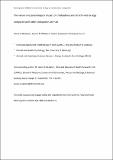Files in this item
The nature and psychological impact of child/adolescent attachment to dogs compared with other companion animals
Item metadata
| dc.contributor.author | Muldoon, Janine Claire | |
| dc.contributor.author | Williams, Joanne M | |
| dc.contributor.author | Lawrence, Alistair | |
| dc.contributor.author | Currie, Candace | |
| dc.date.accessioned | 2020-12-07T15:39:38Z | |
| dc.date.available | 2020-12-07T15:39:38Z | |
| dc.date.issued | 2019-01-04 | |
| dc.identifier | 244956377 | |
| dc.identifier | 674e66cc-23f5-4644-a73e-5430c573be97 | |
| dc.identifier | 85059965327 | |
| dc.identifier | 000457833600005 | |
| dc.identifier.citation | Muldoon , J C , Williams , J M , Lawrence , A & Currie , C 2019 , ' The nature and psychological impact of child/adolescent attachment to dogs compared with other companion animals ' , Society & Animals , vol. 27 , no. 1 , pp. 55-74 . https://doi.org/10.1163/15685306-12341579 | en |
| dc.identifier.issn | 1063-1119 | |
| dc.identifier.uri | https://hdl.handle.net/10023/21060 | |
| dc.description | This work was partially supported by the Department for Environment, Food and Rural Affairs [grant numbers AW1404 and AW1407] | en |
| dc.description.abstract | Building on a study examining children’s knowledge and care of companion animals, this paper examines emotional attachment to dogs. It uses a large-scale dataset on children’s health and well-being (n = 6,700) to explore the connection between attachment to dogs, compared with other companion animals, and a range of well-being indicators. Findings reveal stronger attachments to dogs that are linked with well-being. Some associations are also evident for children reporting a strong bond with small mammals. A mixed pattern of results is evident for cats, and no associations were apparent for those with fish, reptiles, or amphibians. Relationships with dogs appear distinctive; children’s sense of emotional reciprocity and shared enjoyment of play act as possible mechanisms by which attachment translates into benefits. Emotional connections to all types of animals investigated in this study weaken with age. This may be due to the changing nature of attachment as children move through adolescence. | |
| dc.format.extent | 20 | |
| dc.format.extent | 866196 | |
| dc.language.iso | eng | |
| dc.relation.ispartof | Society & Animals | en |
| dc.subject | Attachment | en |
| dc.subject | Children | en |
| dc.subject | Companion animal | en |
| dc.subject | Dogs | en |
| dc.subject | Well-being | en |
| dc.subject | H Social Sciences | en |
| dc.subject | RJ Pediatrics | en |
| dc.subject | NDAS | en |
| dc.subject.lcc | H | en |
| dc.subject.lcc | RJ | en |
| dc.title | The nature and psychological impact of child/adolescent attachment to dogs compared with other companion animals | en |
| dc.type | Journal article | en |
| dc.contributor.sponsor | Dept for Environment Food and Rural Aff | en |
| dc.contributor.institution | University of St Andrews. School of Medicine | en |
| dc.contributor.institution | University of St Andrews. Child and Adolescent Health Research Unit | en |
| dc.contributor.institution | University of St Andrews. Population and Behavioural Science Division | en |
| dc.contributor.institution | University of St Andrews. WHO Collaborating Centre for International Child & Adolescent Health Policy | en |
| dc.identifier.doi | https://doi.org/10.1163/15685306-12341579 | |
| dc.description.status | Peer reviewed | en |
| dc.date.embargoedUntil | 2020-12-04 | |
| dc.identifier.url | https://brill.com/view/journals/soan/27/1/article-p55_5.xml | en |
| dc.identifier.grantnumber | AW1407 | en |
This item appears in the following Collection(s)
Items in the St Andrews Research Repository are protected by copyright, with all rights reserved, unless otherwise indicated.

